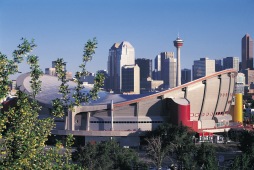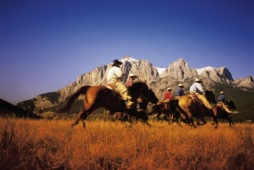
|
|||||||||||||||||||||||

|
|||||||||||||||||||||||
Alberta, Canada
|

|
||||||||||||||||||||||
Calgary hosted the Winter Olympics in 1988 and is home of the Calgary Stampede, which attracts millions of visitors each year. Alberta's Badlands offer Canada's dinosaur capital with the world's largest dinosaur and the Royal Tyrrell Museum in Drumheller. There is lots to explore in Alberta, including the abundant wildlife, the countless historic sites, and the diverse scenery. The province of Alberta was named after the fourth daughter of Queen Victoria, Princess Louise Caroline Alberta, who was married to Canada's fourth governor general the Marquis of Lorne. Alberta in Figures
In the north Alberta borders to the Northwest Territories, in the east to the province of Saskatchewan, and in the west to British Columbia. About half the population of Alberta has neither an English nor French background. Prominent nationality groups are German, Ukrainian, Scandinavian and Dutch. About 3 per cent of the population is Native Indian. Edmonton, the most northerly of Alberta's major cities, is also its capital, and home of 937,845 Albertans. Calgary with a population of 951,395 is the largest city of Alberta. Alberta can be traveled year round, however the peak season is in the months of July and August. Arrival The most common way to Alberta is via Calgary by plane. In the summer months there are daily non-stop flights from Europe. Flights are offered by Air Canada and Lufthansa as well as by British Airways. British Airways flights generally have a stop over in London. You should compare prices as there are many specials you can benefit from. Swiss Air offers service from Switzerland. Traveling within Alberta
Alberta is a paradise for bicycle enthusiasts with wide, smooth shoulders on breathtaking corridors such as the Icefields Parkway from Lake Louise to Jasper (229 km or 142.3 miles). There are many routes to discover. Between Jasper/Calgary and Vancouver the legendary Rocky Mountaineer offers a romantic train ride through the beautiful Rocky Mountains. If you exactly know, where to go you can also take a domestic flight. Most towns have an airport with daily service. Means of payment Besides the most common credit cards (Visa, Master Card and American Express) you might consider carrying some Traveler's Cheques in small denominations. Those are generally accepted like cash and have the advantage of being insured. However you should always carry some cash, especially if you intend to push forward to more rural areas. Here cash is the only thing that counts as most of the small shops do not have the equipment to accept credit cards. You should not bring German Marks or American Dollar in order to pay your bills as American Dollars are only accepted near the US border. Prices All prices are generally subject to applicable taxes, which might be uncommon for European travelers. Taxes are added when you pay. Alberta is the only province in Canada with no Provincial Sales Tax (PST). However, it has a five per cent hotel tax. Usually you have to pay 7 per cent taxes (7 per cent GST Goods and Service Tax), but some merchandise is tax exempt. Waiters in a restaurant generally require a tip, which is added to the bill's total as this is sometimes the only pay they receive. It is up to you, how much you leave, but 10-15 per cent is fairly common. Usually you leave the tip on the table as you go. Tip is also given to cabbies, hairdressers, barbers, hotel attendants and bellhops. We recommend saving all receipts, as tourists who have their place of residence outside of Canada might be eligible for tax refund. However, this only applies for amounts over CAN $50,00 per receipt (except accommodation receipt where no minimum amount applies) and a minimum of CAN $200,00 in total. Not eligible for tax refund are bills paid for gas or transportation. In any case it might be worthwhile to save receipts for accommodations or larger purchases that are exported. The application for tax refund can be found at the website address shown below. You can file your application up to six months after you have left the country and has to be in writing. A refund cheque will than be mailed to your home address. If you came by plane you are required to send your bording pass with your application. Receipts for goods have to be validated by Canada Customs as you leave Canada. For further information visit Visitor Tax Refund. Opening Hours Usually stores in Alberta are open 10 am to 6 pm. Some might be open till 9 pm and grocery stores often offer a 24 hour service, which also applies to gas stations who regularly have a convenient store attached. In summer months usually longer opening hours apply. The post office generally closes at 5 pm, banks sometimes already at 4 pm. National Parks and Provincial Parks
World Heritage Sites Alberta has following World Heritage Sites: History
Both, the Hudson's Bay Company and the Northwest Company, set up trading posts throughout the province and amalgamated in 1821. The company tried to keep settlers out of the area. In 1870 the Hudson's Bay Company turned over control of the entire Northwest to the Dominion of Canada, which in return opened the area for settlement. The Northwest Mounted Police, later to become the RCMP, has been established in the 1870s to bring law and order to the area. One of the first tasks was to control the whiskey trade, in which First Nations were given cheap alcohol in exchange for bison hides. The first settlers were ranchers, who found Alberta's ideal ranching country. When the railway arrived in 1883, the West was opened for settlement and the population grew quickly. In 1897, Canada's minister of the interior, Clifford Sifton, began a massive advertising campaign in Europe to encourage people to come to the Canadian West. This campaign turned out to be a huge success. In 1881 there were about 17,500 settlers who called Alberta their home. In 1921 this number had skyrocketed to 584,000. In 1905 Alberta became a province of Canada and Edmonton became its capital. Between the World Wars the economy slowed down, but in 1947 a major oil discovery near Edmonton should change the province entirely. Employment was created in the petrochemical industry as well as in the transportation industry. Today energy, telecommunication and tourism are the largest sectors for Alberta's economy. |
|||||||||||||||||||||||
|
More Travel Tips for Alberta
Circle Tours Circle Tour National Park Hopping BC & AB
|
|||||||||||||||||||||||






